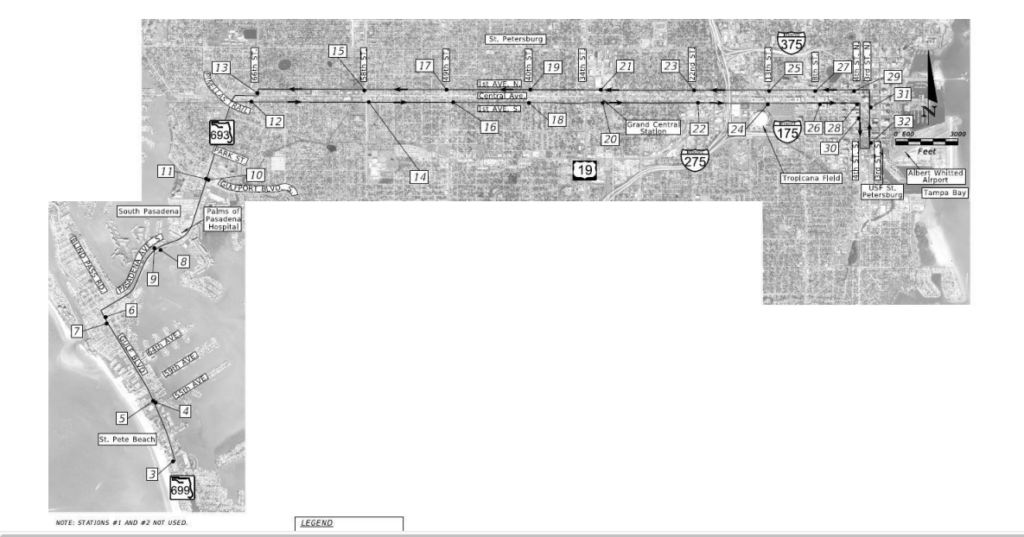Thrive
Local leaders gather to celebrate $21.8 million transit investment

Pinellas Suncoast Transit Authority CEO Brad Miller confirmed what Thursday was just tweets and rumors: the Federal Transit Authority has allocated $21.8 million to the Central Avenue Bus Rapid Transit (BRT) project.
The Central Avenue BRT project will be the first transit project of its kind in Tampa Bay, and represents the largest single capital investment of public transportation in Pinellas County history. The BRT line will connect downtown St. Petersburg to St. Pete Beach with fast and consistent service, cutting the current 55-minute one-way Central Avenue Trolley service to just 35 minutes. It is expected to form the bedrock for future Tampa Bay transit improvements, eventually connecting St. Petersburg and Pinellas County to Downtown Tampa and Tampa International Airport.
Previous Coverage: President Trump announces funding of St. Pete BRT project via Twitter
“This is an incredible day, this is a day that Pinellas County, St. Petersburg, Tampa Bay, the whole region, got a little bit better,” said Miller. “It is enormous for public transit, it makes us immediately a lot better.”

A screenshot from H.W. Lochner’s Central Avenue BRT plan submission to the Southwest Florida Water Management System.
Miller, who announced the funding allocation Friday in a socially-distanced press conference, reminisced about the hard work that brought the funding to fruition, which started with submitting the grant application as Hurricane Irma raced toward Pinellas County three years ago.
“I think it shows that determination, putting your head down and constantly working and being focused toward your goal, that’s the key to this project’s success,” he said. “I know it will be successful, we are on our way.”
St. Petersburg Mayor Rick Kriseman appeared energized by the announcement, and christened the project an immense economic driver and a win on multiple fronts.
“This is about economic development. This is about quality of life. This is about climate change,” Kriseman explained “This project, the first of its kind in the Tampa Bay Area to provide real mass transit options, addresses all of those things.”
Kriseman said the BRT line will be the start of a transit system that will allow St. Petersburg to compete with peer cities across the country on more comparable terms. “If we’re going to compete for the businesses that we want to bring to the Tampa Bay Area, to the City of St. Petersburg, to Pinellas County, we have to have great mass transit, because the other communities we’re competing with around the country have that,” Kriseman said. “We need it, and if we have it, they’ll come here because we’re better than they are.”
Kriseman also attached the transit project to quality of life, affordable housing and transportation concerns for lower-income residents of the county, who rely on public transit to get around.
“A lot of the people who live in St. Petersburg work on the beach and its tough for them to get to work,” Kriseman said. “This will provide them with an easier way of getting back and forth to work.”
Finally, Kriseman said, the project is a boon for the city’s fight against climate change. “Getting people out of their cars and using mass transit. What a great way of addressing climate change and helping us achieve our goal of reducing our carbon footprint by 80 percent by 2050,” he explained. “This is how we do it, folks.”
Pinellas County Commissioner Janet Long, a longtime advocate of the project, expressed her excitement as well. “This was a tremendous team effort from our business community, our elected officials, and all of the regional partnerships that we have built over the last five or six years,” she said.
“This project is the catalyst that will propel the 41-mile mile plan that will run all the way from downtown St. Petersburg out to the beaches, all the way up to the Howard Frankland, into downtown Tampa, out to the University and Wesley Chapel in Hillsborough County.”
Long also hinted at a second project seeking federal funding, which would soon be coming down the pike.
While he did not attend the press conference, Representative Charlie Crist, a member of the House Appropriations Committee, and supporter of the Central Avenue BRT project, released a statement praising the allocation.
“With these federal dollars, this state-of-the-art project will finally become a reality,” Crist said in a statement. “The new BRT line will increase accessibility to the beaches for tourists, hospitality industry and other workers, and take more cars off the roads. I look forward to its completion and a new way of moving Pinellas forward!”
The $21.8 million in federal funds will join with the $10.5 million from the Florida Department of Transportation, $7.6 million from the PSTA, and $4 million from the City of St. Petersburg. The total estimated cost of the project is $43.9 million dollars.


M Genellie
May 29, 2020at3:30 pm
Great win! What fuel will power these busses…as we look to reduce the carbon footprint?